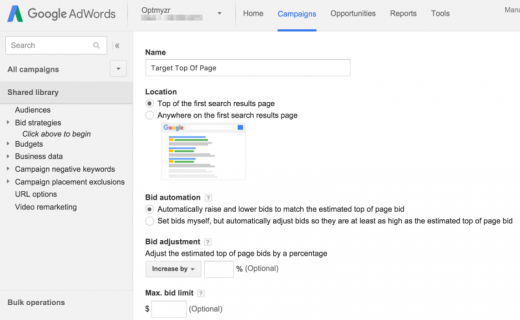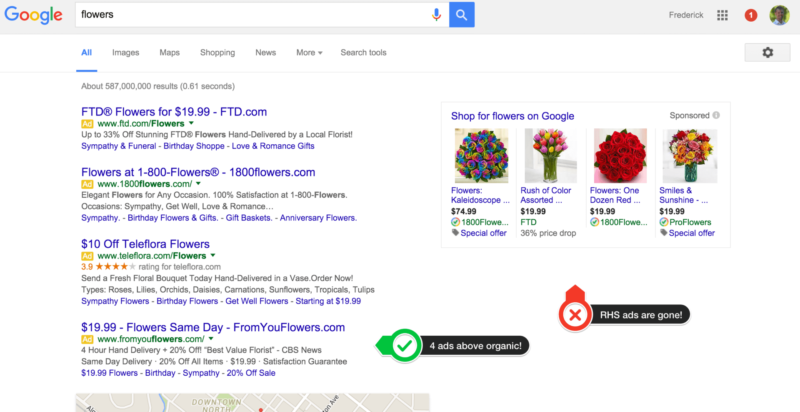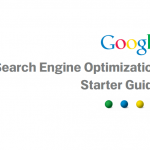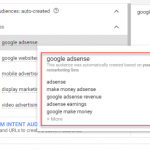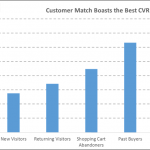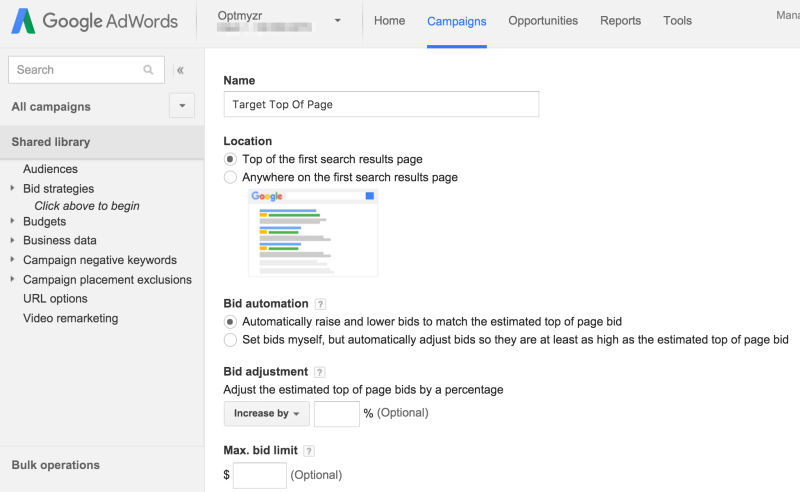How advertisers must respond to fewer ads exhibiting on Google
Google not too long ago changed the way in which ads are displayed on search engine outcomes pages, so how will you take advantage of this variation? Columnist Frederick Vallaeys lays out some options.
After a quiet start to the year with few remarkable adjustments in AdWords, the closing month has considered plenty of interesting issues happening, most particularly the change to the format of ads on the search results pages.
I’ve shared my initial ideas about this transformation on my firm blog; however now that it’s been live for a couple of weeks, i wanted to weigh in with how you can optimize debts which might be impacted, including the usage of bid to place rules and high quality score optimization.
What changed to commercials on Google
The week of February 19, Google began getting rid of right-hand side (RHS) commercials, reserving that area as a substitute for product record commercials (PLAs) and the information Panel. this modification diminished the utmost choice of text commercials on the page from eleven to seven.
a transformation as important as this one led to some angst amongst advertisers, but the influence seems neutral to sure, consistent with a few items of analysis: iProspect referred to that RHS advertisements had a terrible click-thru rate (CTR) anyway; Merklechange and located no major affect to the enormous picture; and others reacted in a similar way. Google’s personal Matt Lawson even stated that “[i]n combination, this transformation is neutral for small advertisers.”
I’ve run a number of estimates of my very own (which I’ll share under) to gauge the affect of the exchange, and i also think it is a web certain alternate because it opens up an awfully massive selection of new clicks to advertisers.
despite all the studies concluding that the mixture or moderate change might be neutral or positive, remember that person results could fluctuate. None of us are averages. We’re all individuals, so we need to pay shut consideration to how we’re personally impacted with the aid of the trade.
This being election season, let me put it like this: If some of the presidential candidates proposed adjustments to taxation that would reduce taxes, I wouldn’t vote for that candidate without first checking that my particular person taxes would also go down — the mixture of all taxes has no influence alone financial institution balance.
The change makes 18% more clicks available
This clarification comes from my past blog post, but should you overlooked it, I’m including it with some extra detail right here because this goes to the center of why I imagine this can be a certain exchange.
Let’s imagine two data before we estimate what influence this alteration could have.
- In 2011, when I was once on the workforce at Google, we got here to the conclusion that “on average, this [bottom ad] placement carried out higher than aspect ads with regards to click on-through fee in our tests.”
- As has been broadly lined as part of this transformation, advertisements shown at the high of the web page have a considerably higher click on-through price (CTR) than the same commercials on the RHS.
iProspect says that the CTR of the highest commercials is 14 instances that of RHS advertisements, so if the CTR of a RHS advert is the unknown x, then a top ad’s CTR would be 14x.
- RHS advert CTR: x
- prime advert CTR: 14*x (prime advertisements perform 14 occasions better than RHS advertisements)
Now, let’s run some estimates to assist resolve what the trade could mean to advertisers. To simplify the example, we’ll assume there used to at all times be three commercials at the prime and 8 on the RHS, and there will now always be 4 at the top and three at the backside. obviously this isn’t the case, but it’s just right sufficient to allow us to evaluate some conceivable numbers sooner than and after the trade.
sooner than the exchange, advertisers had been competing for the clicks from three top advertisements and 8 RHS advertisements. this is how many clicks there was once on hand for every ad impact:
- 3*14x (for the three prime ads) + 8*x (for the eight RHS commercials) = 50x clicks (the whole clicks of a page)
needless to say, x is the CTR of an advert on the correct. Let’s say it’s 2%, in order that implies that for every search, Google expects one click on between all of the 11 commercials on the page.
If Google simply eliminated the RHS ads, they’d have decreased possible clicks by sixteen%:
- -8x (for the 8 RHS advertisements which might be long past)/50x (for the entire clicks of the web page prior to the alternate) = -16%
however remember they’re adding one new ad on the prime and that one might also get 14 times the clicks of a RHS advert, so right here’s what number of clicks we can expect from four commercials at the prime:
- four*14x (for the four top advertisements) = 56x clicks
That’s a 12% growth from ahead of — however we’re now not achieved, as a result of among the outdated RHS commercials now transfer to the bottom, the place we predict them to get a greater CTR than sooner than. but let’s simply assume their CTR stays exactly the same in their new place:
- four*14x (for the 4 prime commercials) + 3x (for the three bottom commercials) = 59x clicks
So with this transformation, Google may have very neatly gone from 50x clicks to 59x clicks for every question, an increase of 18%.
- (59x – 50x)/50x = +18%
again, remember the fact that x is the unknown CTR of a RHS advert. If that was once 2%, then for each search, Google might now expect 1.18 clicks between all the seven advertisements on the web page.
What occurs after we add in what we’ve viewed so far
Mark Ballard and Andy Taylor from RKG suggested that top ad CTRs have declined round five p.c as a result of there may be one further ad to click on on, whereas bottom advertisements have greater CTR with the aid of 60 percent as a result of there are fewer to choose between.
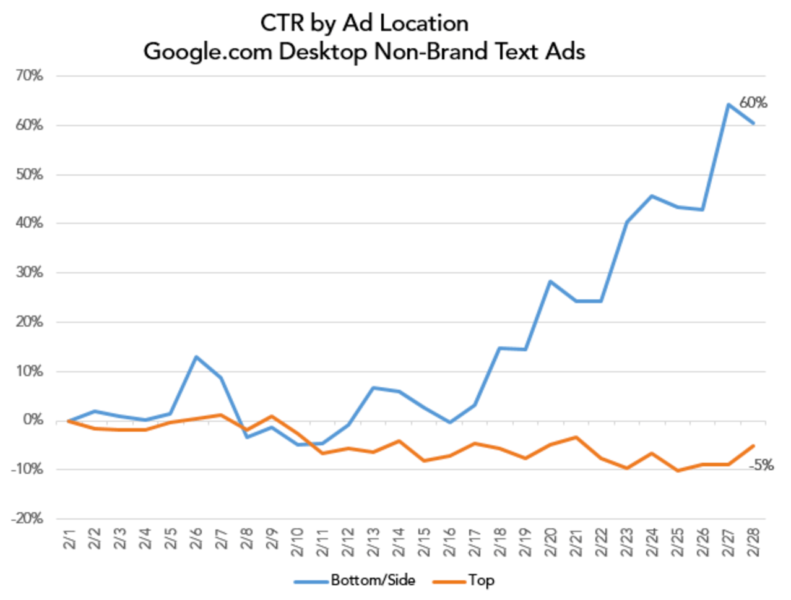
high advertisements CTRs have declined 5 % by adding one more advert. backside advertisements have elevated CTRs by 60 % by means of displaying fewer ads in a better vicinity below the hunt outcomes.
If we add these numbers to my estimates, here’s the potential of new clicks that at the moment are available:
- four*14x*(1–5%) (for the four top ads) + 3x*(1+60%) (for the three backside ads) = 59x clicks
- 53.2x + four.8x = 58x
This still leaves us with a sixteen% acquire in imaginable clicks:
- (58x – 50x)/50x = +sixteen%
Are there actually more clicks available now?
whereas I argue that the alternate may make sixteen % more clicks available, the fact is that we most definitely won’t see this elevate immediately as a result of Google still controls what number of advertisements show above the results, and they may fine-tune that threshold to keep the auctions rather constant.
As time goes on, Google may just play with this threshold, and we could ultimately see the whole affect of all of the newly available clicks.
learn how to get the advert Rank needed to be prime 4 or prime 7
Returning to my level that averages and aggregate numbers don’t matter, what can particular person advertisers do to fortify their outcomes if they don’t seem to be ok with the CPCs or advert Ranks because the change?
Our to be had levers to vary advert Rank have now not modified, in order to either trade the bid (which is fast and straightforward) or try to alternate our quality ranking (harder to do).
we are able to also give a boost to our ad extensions like Sitelinks, which might be now extra essential as a result of all advert positions have the distance to indicate all extensions (something that wasn’t the case for RHS ads that had less horizontal monitor-property to play with).
answer 1: Bid to position
one of the best ways to make your ads eligible to appear above the hunt results is to use a bid-to-place methodology to attempt for place 4 or better.
Google has a versatile Bid strategy referred to as “goal search page region,” where we are able to choose from aiming for the top of the web page or the first web page of outcomes. Google will mechanically trade the bids as needed to take a look at and reach these positions.

Use Google’s “target Search page region” flexible Bid technique to get your ad to point out on the prime of the page or on the first page of outcomes.
on the other hand, advertisers can use bid rule engines they write themselves to steer their ads toward the specified reasonable target place.
When the usage of programs like these (like automated ideas), needless to say to remember the fact that the average place shown in AdWords regularly comprises data from search partners, and for broad in shape key phrases, information from the entire quite a lot of queries.
try to filter that data right down to a narrowly defined set of knowledge factors — for instance, actual match on Google Search most effective. if you happen to don’t define it this narrowly, then any exchange in bids will alternate the query combine, and that may skew the averages dramatically, making it not possible to compare apples to apples.
When using Google’s flexible Bid strategy, there’s an approach to exclude any keywords with a high quality score (QS) of three or much less. it’s because bidding extra for low QS key phrases can be cost-prohibitive, and these key phrases could be higher served with a QS optimization first.
answer 2: enhance high quality score
whether you’re taking a look to make stronger QS as a result of your keywords have a low QS or since you’d reasonably spend time than money to support ad Rank, the good news is that Google’s studies now embody the three sub-elements of QS, making it more straightforward to determine the best way to make stronger QS: ad textual content relevance, expected CTR or touchdown page experience.
right here’s one technique to utilize the new knowledge from Google:
- identify key phrases which have a “below average” rating for ad text or landing web page.
- take a look at if these key phrases are in an advert staff where other keywords are “reasonable” or “above average” for the same sub-parts of QS.
- If yes, then transfer these key phrases to new ad teams and check out a new ad or touchdown web page in line with the at present easiest-performing variant within the ad crew for the selected keyword.
- If NO (and all keywords within the advert workforce are “beneath moderate”), then rewrite the advert in the advert workforce or change the touchdown pages, seeing that all key phrases may benefit equally.
In theory, this is pretty straightforward; in observe, this may make the effort. AdWords doesn’t have a report that shows each the keyword-degree small print like QS and the ad textual content efficiency segmented by means of key phrase. which you could download an advert textual content record segmented by key phrase, however this won’t embrace QS details.
At Optmyzr, we’ve written a freebie AdWords Script that generates the needed file that merges the entire knowledge about keywords and commercials. that you could obtain it right here. if you want a primer on how AdWords Scripts work and easy methods to add this one to your account, there was an incredible sequence by way of Ginny Marvin on this site a few year ago.
here’s an instance of the output of my script:

The AdWords Script generates a Google Sheet with both advert textual content degree knowledge and keyword level attributes just like the three parts of high quality ranking.
Now it’s simple to look for “under reasonable” ad textual content relevance amongst keywords in advert groups which have some “moderate” or higher ad textual content relevance. From there, that you would be able to take the segmented CTR knowledge from the present commercials to create a new ad workforce that eliminates the worst CTR advertisements and take a look at a few new ad texts.
within the instance above, notice that probably the most advert texts has a better CTR; that must be the place to begin for brand new experiments where we attempt to boost our ad text relevance.
Conclusion
while the reduction of ads on the Google search outcomes pages may seem love it’s making fewer clicks available, I consider this change will significantly elevate the choice of clicks on hand.
Now it’s as much as advertisers to duke it out for who gets their piece of the bigger pie. With some straightforward changes in account administration methods associated to bid management and high quality score optimization, advertisers will have to find themselves neatly put to take advantage of this change.
[Article on Search Engine Land.]
Some opinions expressed in this article could also be those of a visitor author and not essentially advertising and marketing Land. body of workers authors are listed right here.
(Some photography used beneath license from Shutterstock.com.)
advertising Land – internet advertising news, strategies & guidelines
(72)

